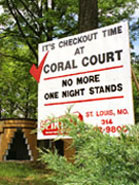







Actions by retail developers and the motel owners in the late 1980’s
and the early 1990’s, led architectural experts and Coral Court fans
on a preservation crusade. Unfortunately, even a listing on the National
Register of Historic Places, pushed for and received in 1989, did not
provide protection from the wishes of its owners, private developers and
a demolition permit. A property on the National Register is only protected
if federal funds are involved. Also, the Village of Marlborough had no
local historic preservation laws like the City of St. Louis; even after
the State of Missouri passed a law enabling all towns, cities and villages
to have historic preservation districts and ordinances, the village fathers
were simply not interested. The motel owners did not want to be bothered
with Coral Court any longer and their attorney advised them to sell.
As the fate of the landmark became clear, the concern of its supporters
shifted to preventing further deterioration of the motel while it was
on the market. Although the motel was roped off and patrolled regularly
by the police, it did not prevent “souvenirs-seekers” and vandals
from breaking into the rooms. Some even loaded the bricks into their cars,
hoping they would become a valuable investment for future resale. Tragically,
they hastened the destruction of the unique landmark.
 The
Coral Court Motel was closed in 1993 and razed two years later. The motel
was actively on the market for nearly 3 years but nobody was able to afford
the $1.5 million pricetag plus the extra $1 million estimated for renovation.
Shortly before its destruction in 1995, Coral Court preservationists remained
loyal. The Museum of Transportation in St. Louis, where a Coral Court
unit was planned to be moved and eventually displayed, could not afford
the more than $100,000 to move the building intact.
The
Coral Court Motel was closed in 1993 and razed two years later. The motel
was actively on the market for nearly 3 years but nobody was able to afford
the $1.5 million pricetag plus the extra $1 million estimated for renovation.
Shortly before its destruction in 1995, Coral Court preservationists remained
loyal. The Museum of Transportation in St. Louis, where a Coral Court
unit was planned to be moved and eventually displayed, could not afford
the more than $100,000 to move the building intact.
Once again, Coral Court fans came through. The museum staff and an all-volunteer
labor force of about twenty, showed up for the bungalow’s solitary
trip to the museum. For two-and-a-half-weeks, they they dismantled the
selected unit, piece by piece; stacking heavy bricks and blocks. Working
on the unit’s outside portion, these determined volunteers unhinged
doorways, lifted garage doors and pried off aluminum windows. While on
the inside, they carefully unscrewed fixtures, coat racks and curtain
rods, and carried out any remaining furniture. History owes all of the
museum staff and volunteers a huge thank-you for their selfless labor.